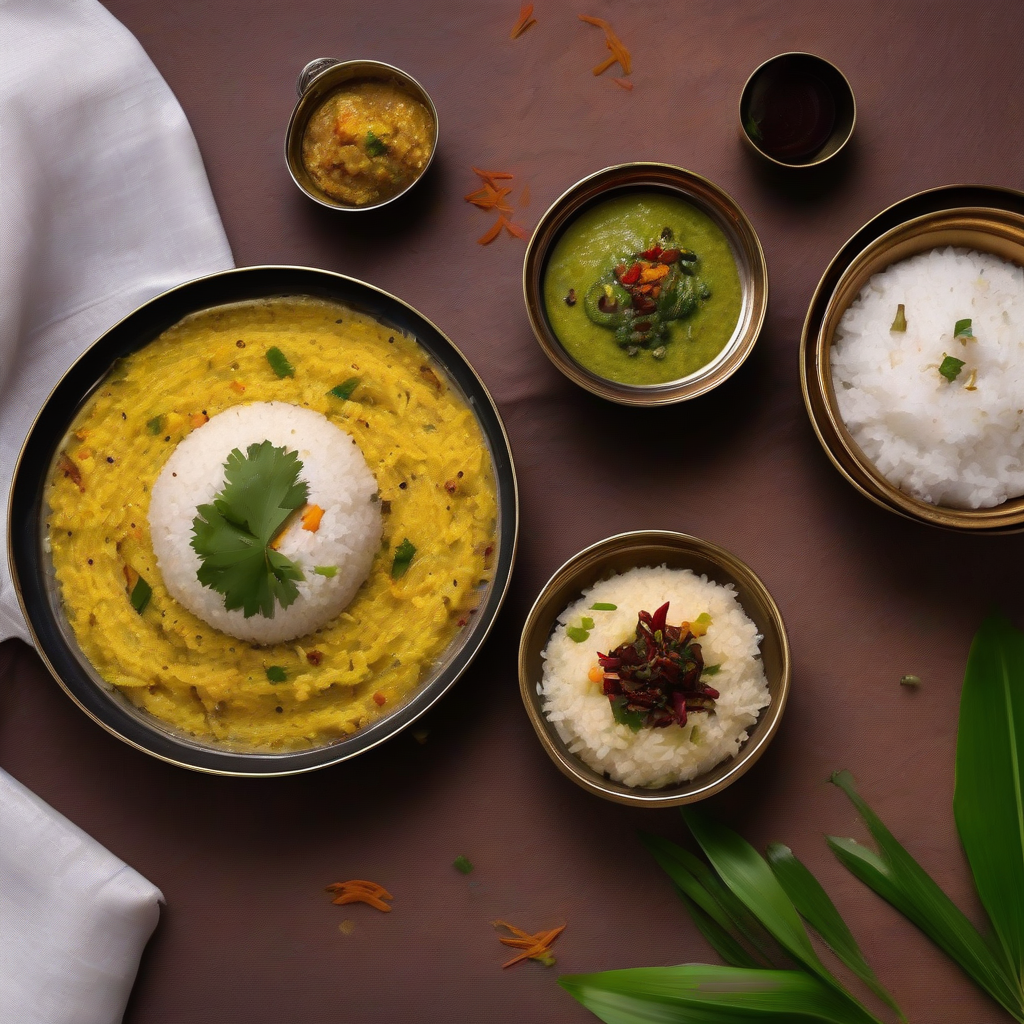Pongal Pandigai Special: Let’s Make Khara Pongal and Coconut Chutney, Yaar!
Namaste and Vanakkam friends! Chef Curry Do’pyaza here, back in your kitchens with a recipe that’s close to my heart and stomach – Ven Pongal with Coconut Chutney! This is comfort food at its finest, a dish that warms you from the inside out.
For my Tamil friends out there, you know Pongal is more than just a dish; it’s a feeling! It’s the taste of harvest festivals like Pongal (obviously!), a staple during auspicious occasions, and a delightful way to start a chilly winter morning. It is also a regular feature in many South Indian homes for breakfast.
A Little Pongal History Lesson
Pongal, meaning “to boil over,” is believed to have originated centuries ago in South India. Early versions, called “Ven Pongal” (white pongal), were simple concoctions of rice and milk. Over time, it evolved into the savory, ghee-laden delight we know and love today. Each spoonful tells a story of tradition, family, and the bounty of the earth.
Ready to Cook? Let’s Get Started!
Preparation Time: 15 minutes
Cooking Time: 30 minutes
What You’ll Need (The सामान)
For the Khara Pongal (Savory Pongal):
- 1/2 cup Pachaarisi (Raw Rice)
- 1/4 cup Paasi Paruppu (Moong Dal)
- 4 cups Thanni (Water)
- 1 teaspoon Jeeragam (Cumin Seeds)
- 1 teaspoon Milagu (Black Peppercorns), crushed
- 1 inch piece Inji (Ginger), finely chopped
- 2-3 number of Pachai Milagai (Green Chilies), slit lengthwise (adjust to your spice level!)
- 1/4 teaspoon Perungayam (Asafoetida)
- 2 tablespoons Ney (Ghee)
- 1/2 teaspoon Uppu (Salt), or to taste
- 1 sprig Kariveppilai (Curry Leaves)
For the Thengai Chutney (Coconut Chutney):
- 1 cup fresh Thengai (Coconut), grated
- 2 number of Pachai Milagai (Green Chilies)
- 1/2 inch piece Inji (Ginger)
- 2 tablespoons Pottukadalai (Roasted Gram Dal)
- 1/4 cup Thanni (Water)
- Uppu (Salt) to taste
For the Tempering (Chutney):
- 1 tablespoon Ennai (Oil)
- 1/2 teaspoon Kadugu (Mustard Seeds)
- 1/2 teaspoon Ulutham Paruppu (Urad Dal)
- 1 number of Varamilagai (Dry Red Chili), broken into pieces
- Kariveppilai (Curry Leaves)
Let’s Get Cooking! (The Recipe)
Khara Pongal:
- Wash and Soak: Gently wash the rice and moong dal together. No need to soak for too long, just a quick rinse is perfect.
- The Main Event: In a pot (or your chosen cooking device – more on that later!), add the washed rice, moong dal, and water.
- Spice it Up: Add the cumin seeds, crushed black peppercorns, chopped ginger, slit green chilies, and asafoetida to the pot.
- Cook it Low and Slow: Bring the mixture to a boil, then reduce the heat to low, cover, and let it simmer for about 20-25 minutes, or until the rice and dal are soft and mushy. Stir occasionally to prevent sticking.
- Ghee Magic: Once the pongal is cooked, add the ghee, salt, and curry leaves. Mix well. The ghee will make it rich and fragrant.
- Smash It Up: Use the back of your ladle to lightly mash some of the rice and dal. This gives the pongal a lovely, creamy texture.
Thengai Chutney:
- Blend It: In a blender, combine the grated coconut, green chilies, ginger, roasted gram dal, water, and salt.
- Grind Away: Grind to a smooth paste. Add more water if needed to achieve your desired consistency.
- Tempering Time: Heat oil in a small pan. Add mustard seeds. Once they splutter, add urad dal, dry red chili, and curry leaves. Fry until the dal turns golden brown.
- Pour and Serve: Pour the tempering over the chutney. Mix well.
Chef Curry’s Top Tips
- Ghee is Key: Don’t skimp on the ghee! It adds a rich flavor and aroma that’s essential to the dish.
- Spice Level: Adjust the number of green chilies to your liking. Remember, you can always add more, but you can’t take it away!
- Consistency is King: Pongal should be soft and mushy. If it’s too thick, add a little more water while cooking.
- Fresh is Best: Use fresh coconut for the chutney for the best flavor.
Pongal Your Way: Cooking Methods Galore!
- Gas Stove: Follow the recipe as written above.
- Induction Stove: Same as the gas stove method.
- Pressure Cooker: Add all the ingredients for the pongal to the pressure cooker. Cook for 3-4 whistles on medium heat. Let the pressure release naturally before opening.
- Slow Cooker/Crockpot: Add all the ingredients to the slow cooker. Cook on low for 4-6 hours or on high for 2-3 hours, until the rice and dal are soft.
- Microwave: Not recommended for best results, but in a pinch, you can try cooking the rice and dal in a microwave-safe bowl with water. Check and stir frequently.
I don’t recommend the use of Oven and Air Fryer for this recipe
Nutritional Nibbles (Approximate Values)
- Pongal (per serving): Calories: 250-300, Protein: 8-10g, Carbohydrates: 40-45g, Fat: 8-10g
- Coconut Chutney (per serving): Calories: 80-100, Protein: 2-3g, Carbohydrates: 5-7g, Fat: 6-8g
Disclaimer: Nutritional information is approximate and may vary based on specific ingredients and portion sizes.
Serving Suggestions
Serve hot Pongal with a generous dollop of Coconut Chutney. A side of sambar or vada adds a nice touch!
Time to Cook, Yaar!
Now that you have the recipe, the history, and all my tips, it’s time to get cooking! Try this delicious Ven Pongal and Coconut Chutney recipe at home. Share it with your friends and family. I know they’ll love it!
Until next time, happy cooking!
– Chef Curry Do’pyaza
